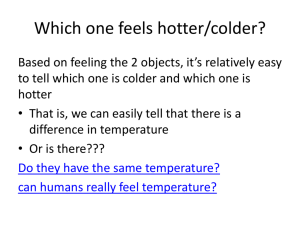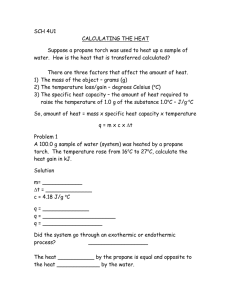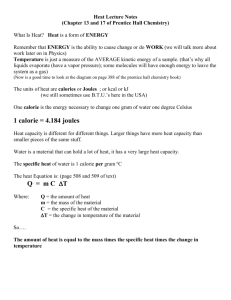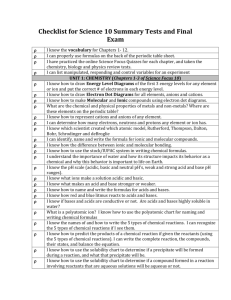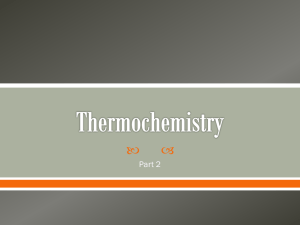Measuring and Expressing Heat Changes
advertisement
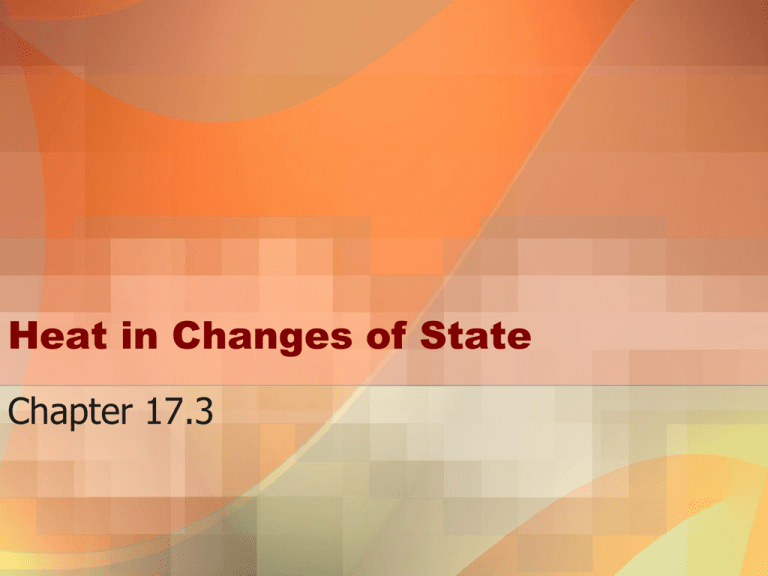
Heat in Changes of State Chapter 17.3 Learning Objectives Understand how to calculate heat (q) when a substance undergoes a phase change Know the definition of heat of fusion/solidification Know the definition of heat of vaporization/condensation Calculate heat change as you heat substance up and pass through a phase change (putting it all together) Different types of heats Molar heats of … describe the amount of heat absorbed/released when a 1 mol of a substance changes state Fusion (Hfus) solid to liquid Solidification (Hsolid) liquid to solid Vaporization (Hvap) liquid to vapor Condensation (Hcond) vapor to liquid Endothermic/Exothermic Endothermic Events (+H) Fusion (melting) Vaporization Exothermic Events (-H) Solidification (freezing) Condensation Pairings Hfus = -Hsolid Hvap = -Hcond Units are sometimes kJ/mol However, Mr. D does not feel we have to use these units since heats (enthalpy) of fusion are often reported for various substances as J/g or kJ/kg. For instance water Hfus = 334 J/g or 79.72 cal/g Hvap = 2260 J/g or 540 cal/g Hsolid = -334 J/g or -79.72 cal/g Hcond = -2260 J/g or -540 cal/g Heating/Cooling Curve Remember what is happening at each point Heating/Cooling Curve: Phase Changes Assume you have 1 gram of water Water is vaporizing Hvap= 2260 J/g of H2O Water is melting Hfus = 334 J/g of H2O (J) What if you don’t have 1 gram of water? You just multiply H of fusion/vaporization by mass Water is vaporizing Hvap= 2260 J/g of H2O q = m x Hvap Water is melting Hfus = 334 J/g of H2O q = m x Hvap (J) Heating/Cooling Curve: No Phase Changes What happens at A, C, and E?? We use our old formula q = m x C x T q=m q=m x Csolid x x Cliq x T q=m T (J) x Cgas x T Heating/Cooling Curve: Putting it all Together You should be able to calculate the total heat going all the way from heating a substance from its solid to its gas q=m q=m q=m q=m x x Csolid x Cliq x x Hvap q=m T Hfus x T (J) x Cgas x T Cool Down Problem You have a 4.30 grams of ice at -13.2oC. You heat it until it completely vaporizes. How much heat was needed to complete this process? Here are some numbers you might need. (Cice = 2.10 J/goC) (Cwater = 4.18 J/goC) (Csteam = 1.70 J/goC) (Hfus = 334 J/g) (Hvap = 2260 J/g) To get answer you simply add these 4 numbers together: 13071 J or 13.1 kJ (3 sig. figs) T (4.30)(2.10)(0.00 - -13.2)= 119.2 J q=m x Cice q=m q=m x Hfus (4.30)(334)= 1436.2 J Cwat x T (4.30)(4.18)(100. - 0.00)= 1797.4 J x q=m x x Hvap = (4.30)(2260)= 9718 J
